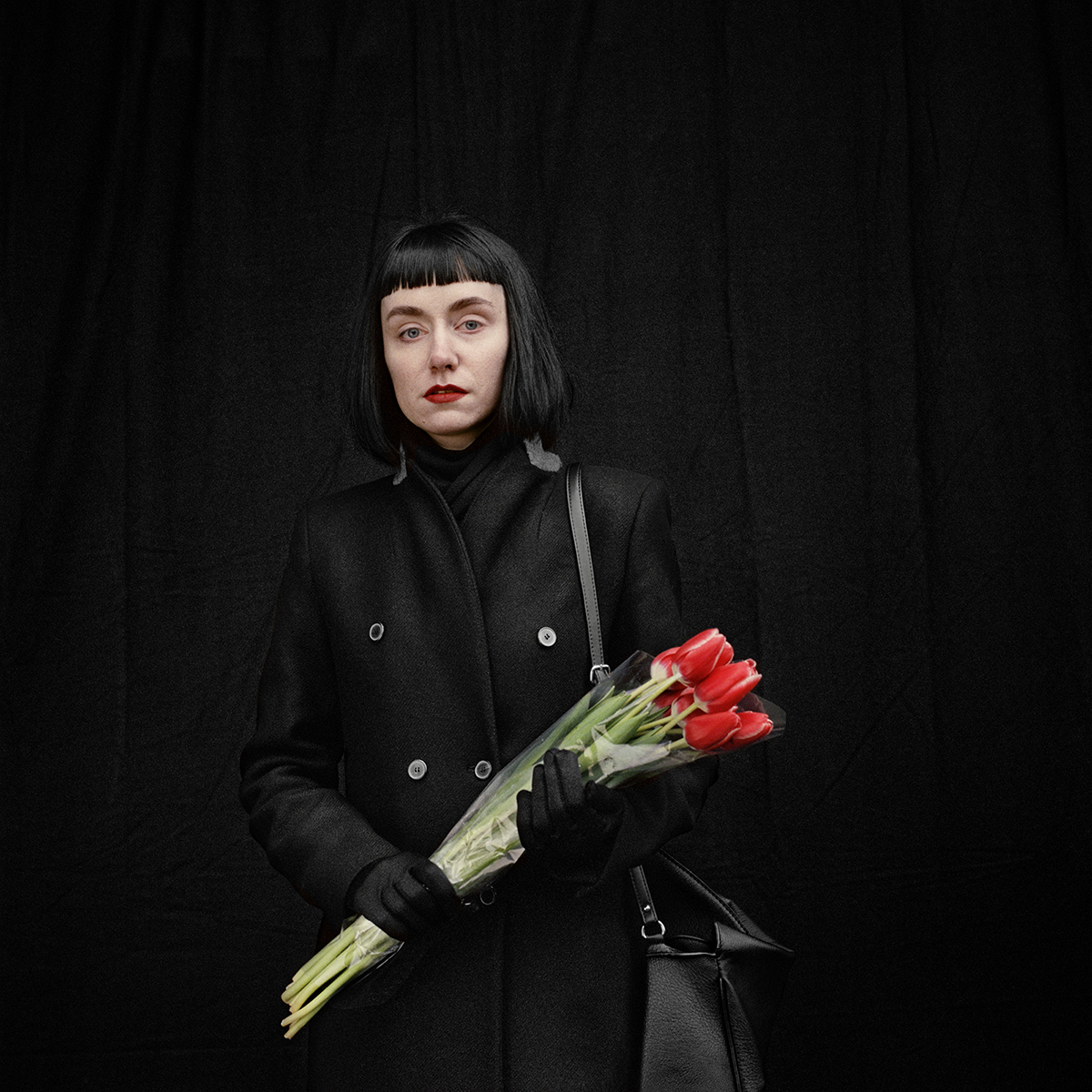
The protestors fighting in Maidan wore their own makeshift uniforms and armor, while the women who later came to mourn them, including Hanna, above, each carried flowers
A tall man in his mid-30s strides past in a camouflage jacket, his face blackened by soot from burning tires. I cheerfully call out to him, “Hi, I’m Nastya from London. Can I make your picture?”
His name is Oleg, and I photographed him twice, on this day and again after the worst day of violence on February 20, which became known as “Bloody Thursday,” when snipers opened fire on protestors fighting security forces loyal to the government, killing about 50 people in a few hours.
The second time I photographed Oleg was different. When we saw him again, he hugged each of us, tightly, unusual for acquaintances in this part of the world. Many men changed like that, as if after all the blood and death they had seen they needed to touch the living and to feel touched and alive themselves. We also felt the trauma of so much violence, and touch comforted us, too.
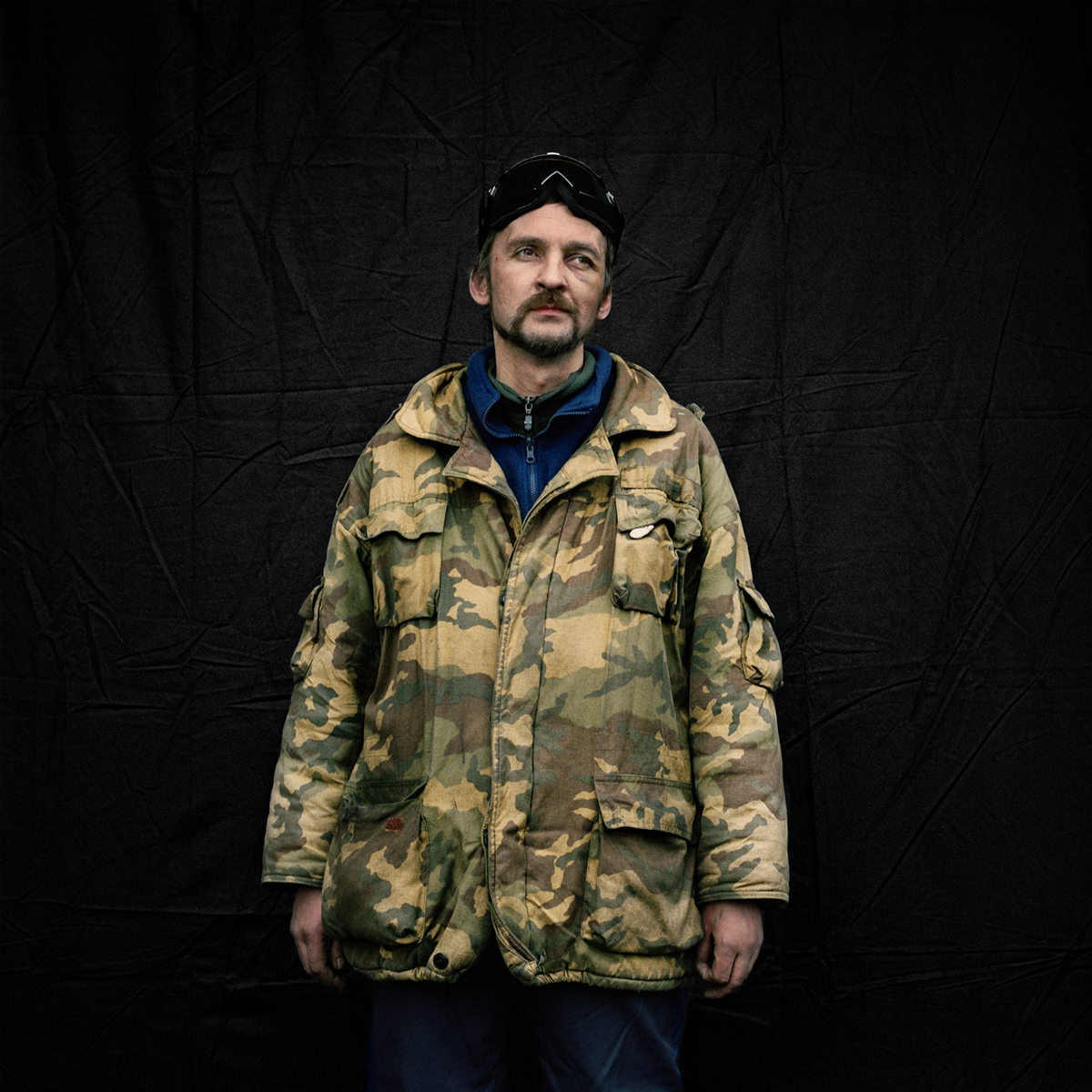
Taylor-Lind photographed Oleg, above, and the other subjects of "Maidan: Portraits from the Black Square" in front the same black backdrop, removing them from the violence of the square
During the 2014 Ukrainian uprising in Kiev, I made a series of formal analog film portraits of male protestors like Oleg and female mourners in that makeshift portrait studio. This work formed my first book, “Maidan: Portraits from the Black Square,” published later that year. But knowing that it would be weeks until the film was processed and scanned in London and weeks more until even I could see the images, I also mounted an iPhone over the viewfinder of my medium-format Bronica camera, recording videos of my interactions with each subject as I made their portrait. These videos omitted the portraits themselves; the shutter firing obscured the actual moment the film was exposed. The videos show everything except the photographs.
The moments that take place between photographs are usually never recorded, and are easily forgotten by the photographer. But I was able to share these moments directly from Maidan via Instagram, using the same device on which the images were made.
Traditionally, what ended up in printed media was considered the “real work.” Today, social media platforms like Instagram give me the chance to broaden the scope and depth of my storytelling by including what goes on behind the camera, images that otherwise would end up on the cutting room floor, or, like the videos of my subjects, would never be captured at all. I am also able to reflect on and respond to viewers’ reactions to my images in real time, while still in the field.
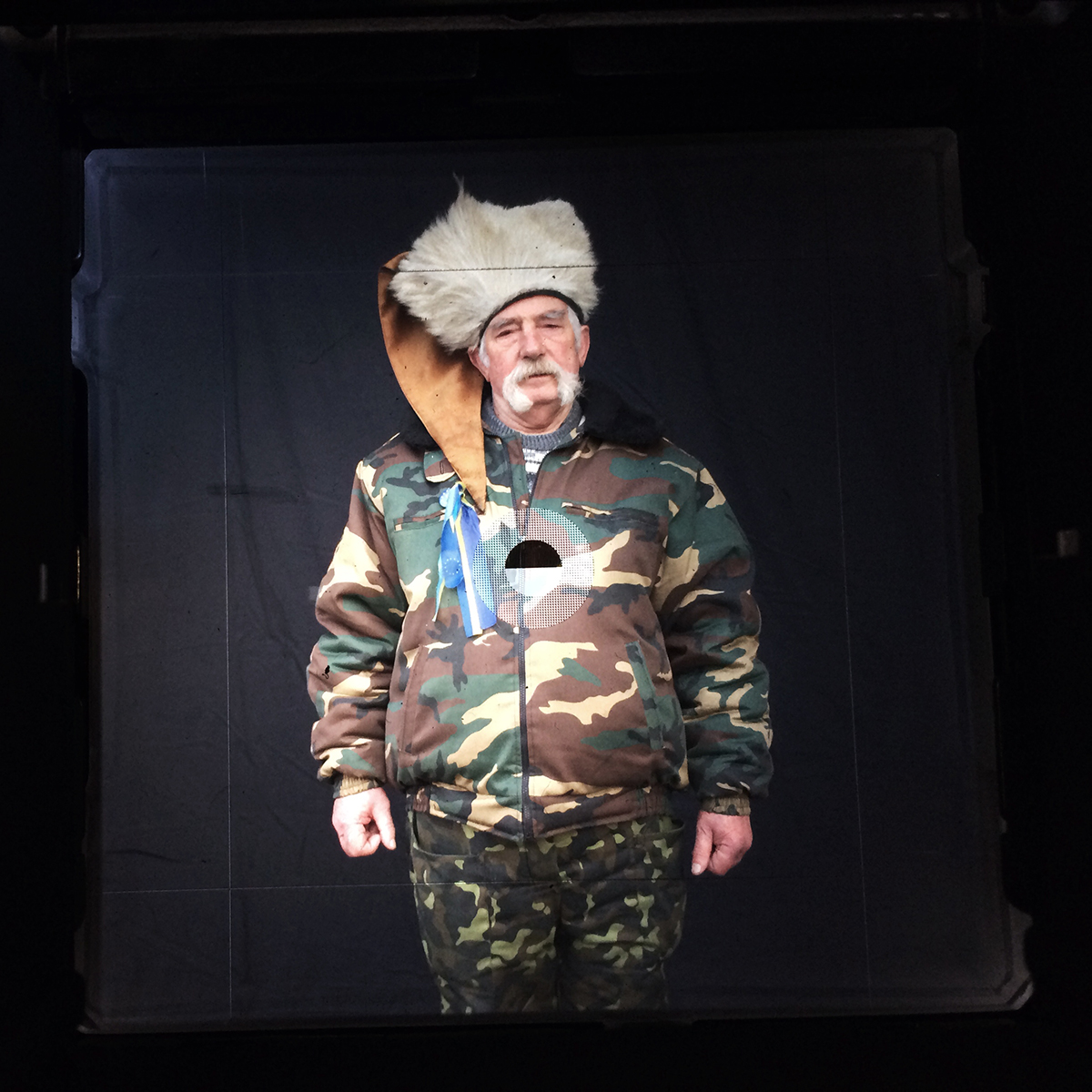
By mounting an iPhone over her viewfinder, Taylor-Lind was able to share the moments before and after photographing Talas, above, for "Maidan: Portraits from the Black Square"
The changing landscape of journalism has forced many of us to change the way we tell stories. I have no choice but to experiment with new tools that technology has gifted me. Social media broadens a journalist’s reach and scope. It allows professionals to share experiences immediately and directly with their audiences. It also allows consumers of images to interact with and influence the creator. This is an enriching experience, for the audience, which feels an increased closeness to events without the middleman of a newspaper or media outlet, and for the photographer, who can learn what moves people to engage with a given subject. This is direct and personal storytelling. Most excitingly for me, it can be a way to engage and include the people in the pictures and the communities from which they come.
My work in Ukraine looks at the domestic landscape of war in the country. Media coverage of the conflict, in which Russian-backed rebels are fighting the Ukrainian army and various pro-Ukrainian militia groups for the separation of the Donbass region, is hugely distorted. Most images depict the Eastern, war-affected region of Donbass, leaving the vast majority of the country undocumented. As a result, one could be forgiven for thinking that the whole of Ukraine looks like Chechnya during the 1990s. But in most of the country life goes on as normal, and the war is not visually present.
I am interested in visualizing this unseen war inside the home, the invisible concepts of normality, familiarity, and violence inhabiting the domestic space. Here, the tentacles of war spread out across the entire country, entering every home and every living room. In most places, you can hear and feel the war, but you cannot see it. I am working with a combination of traditional analog and modern digital storytelling techniques, experimenting with the way social media enables me to make war stories much more personal, immediate, and impactful.
The Maidan videos were intended to be Instagram vignettes of my experiences as a photographer, an intimate look at how I see the world. They show how I saw the men of Maidan: 6cm x 6cm, through the camera’s frosted ground glass, their reflections reversed by the mirror, moving and speaking to me, with the sounds of the revolution all around us. These images break the rules, showing what traditional photojournalism does not have space for: the photographer’s voice and interaction with subjects.
In May, I created an installation at Four Corners Gallery in London, displaying the videos on iPhones placed under actual camera viewfinders, next to prints of the Maidan portraits—a marriage of the digital video experience with the analog process of shooting film. Bringing videos created specifically for dissemination via social media into a traditional gallery context brought the project full circle.
Later that month I returned to Ukraine, utilizing social media to relocate the men and women in “Portraits from the Black Square.” I found 10 subjects, visiting some at their homes to deliver gifts: prints of their portraits. Of course, I documented this process through social media, too.
Ihad tried to document the war in Donbass last summer, making pictures like I usually do: pictures of the war that look like the war, pictures where men and women become “victims,” the “war wounded,” or “collateral damage.” When I edited these pictures afterwards, they failed to move me because they looked like characters from a war story, a story set in a place that looked like a war zone, a place and a people that were unlike me. These images looked so foreign and exotic it was hard for me to imagine that this kind of violence could be visited on my hometown, on my family, and in my life.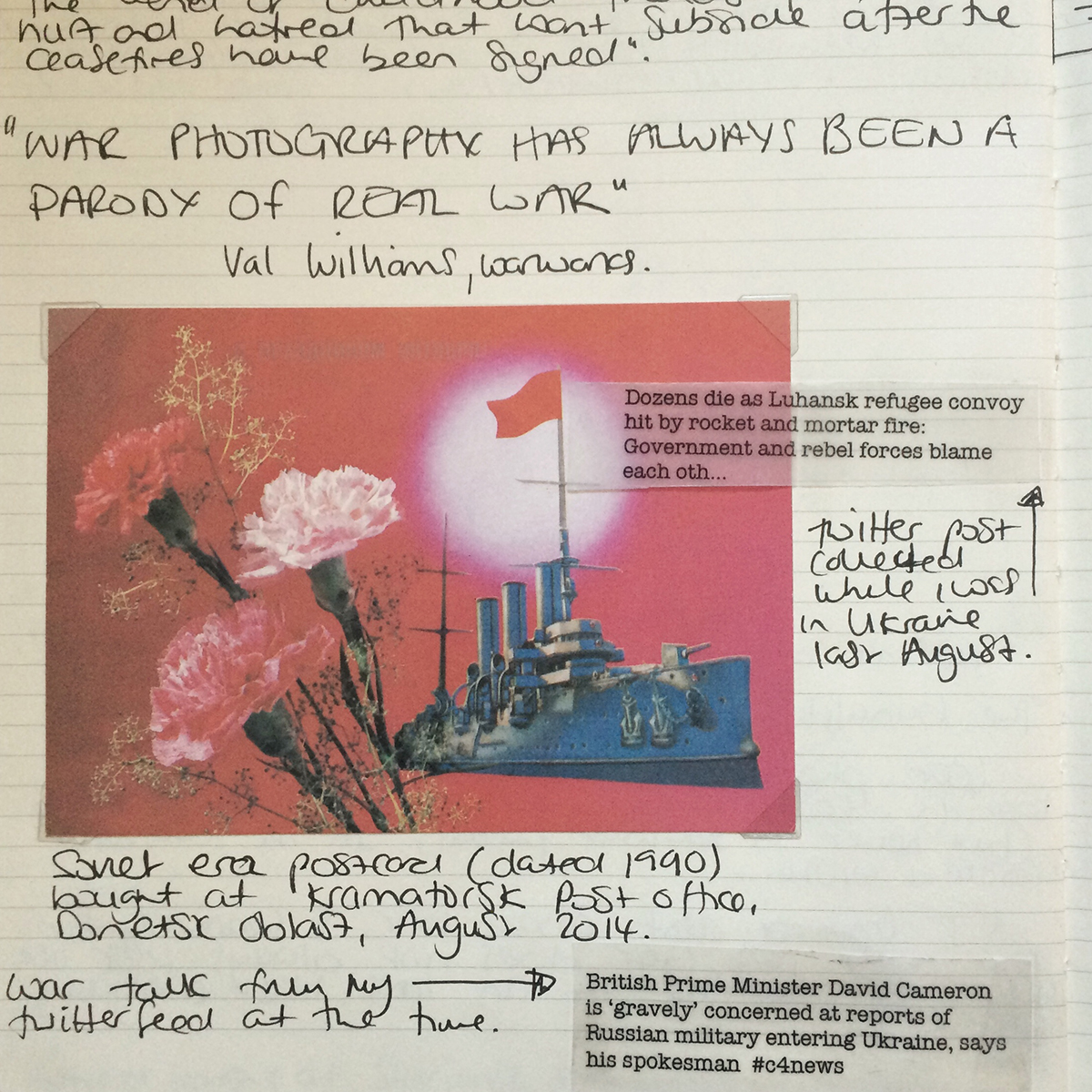
Taylor-Lind uses Instagram to share pieces of her work before publication, including notebooks, clippings, and photographic outtakes
In Ukraine, people always tell me, “We never believed this could happen here.” I’ve heard it before in other places, too. War is always unexpected. It always arrives to the disbelief of the people whose lives it destroys. The photography critic Val Williams wrote in “Warworks,” “War photography has always been a parody of real war.” So, how can I tell a “real” war story? Welcome to Donetsk is my answer.
Welcome to Donetsk is a series of postcards of the capital of the Donbass region that depict peaceful scenes of the city before the war, with the words “Welcome to Donetsk” written over the image. They are real tourist postcards, produced before the war arrived. In these cards Donetsk looks like an ordinary, peaceful European city, like anyone’s hometown, like my hometown. When I look at them, I understand that war is something that happens to ordinary people just like me, before the media reduces them (or us) to refugees and civilians and combatants, the lead characters in media stories around the world.
I came across these postcards in a post office in Slovyansk and was moved to buy them and photograph them for Instagram. The owner of the company that published them closed his business and moved abroad because of the war, but I arranged to buy his remaining stock, which was stored in his mother-in-law’s basement. I traveled to Donetsk to collect the postcards, a grueling, checkpoint-filled, 17-hour journey by train and taxi from Kiev across the frontline.
Back in Kiev, with almost 1,000 postcards, I began posting them all over the world to people whose addresses I collected via social media outreach. My request for participation stated only that I was sending postcards as part of my new project about the war in Ukraine, inviting people to send me their postal addresses if they would like to receive one. Like the Maidan work, this project also merges digital and analog techniques by using mass-communication social media tools to reach specific individuals with a unique and deeply personal story. By the time I finished, I had sent 921 postcards, sharing photographs of some of the cards on Instagram using the hashtag #welcometodonetsk.
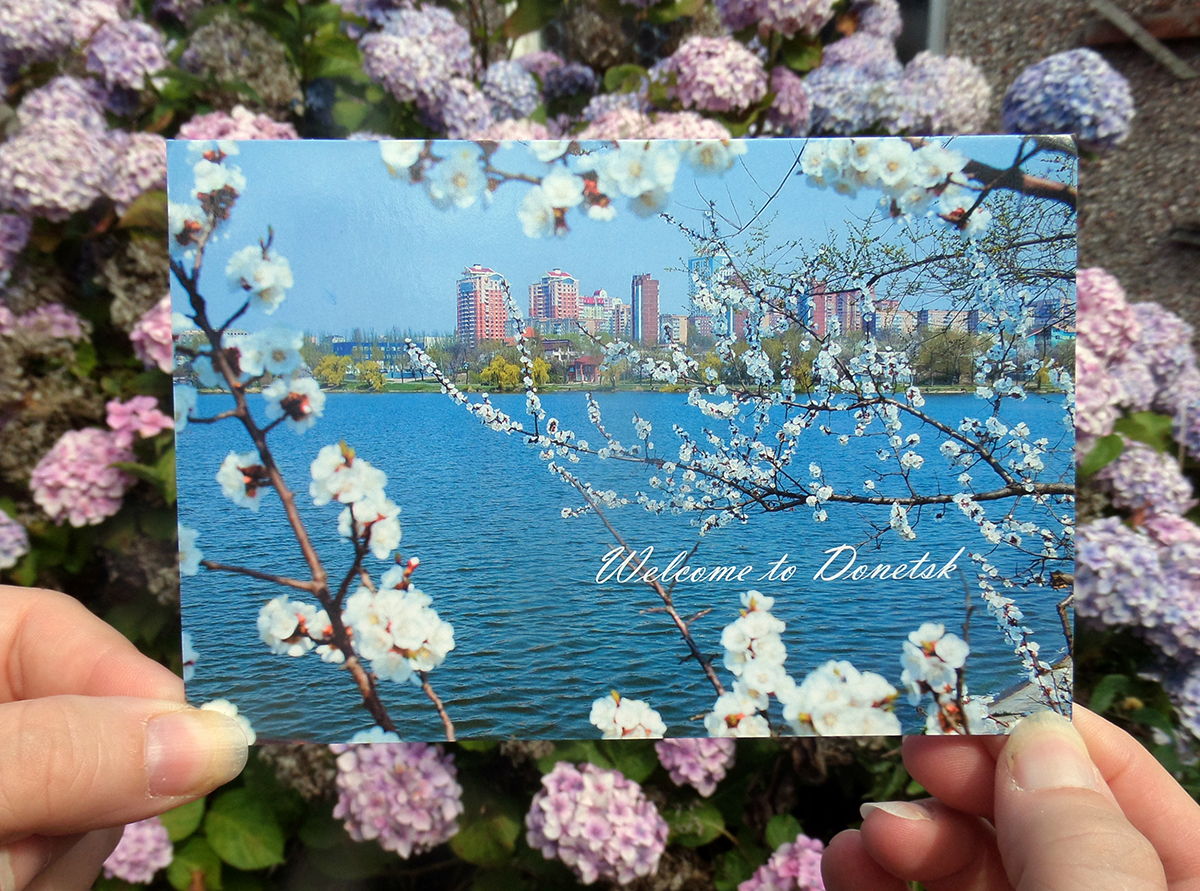
Phil Mansell photographed the postcard he received in the U.K. as a way to commemorate the dead in Ukraine
I wrote each card by hand. On the front is an idyllic image of Donetsk. On the back is the name of one of the 7,962 people so far killed in the conflict, the U.N.’s latest official count, along with the date and place where they died. I list the names of combatants from both sides of the conflict, civilians and journalists, although they are never identified as such. On one side of the postcard is peace, on the other war—but in the same place. If news reports, statistics, and the soulless linguistics of conflict cannot make war personal, maybe one name can, one name I will write just for you.
Valentina Shirokaya was killed in Donetsk on Thursday the 22nd of January 2015.
When Robin Lacey in Totnes, England received his card, he shared a smartphone picture of it and wrote on Facebook: “It is one thing reading or listening to the news, quite another when its personalization lands on your doormat.”
When her postcard reached Cory Zapata in San Diego, her son brought the postcard into class and she gave a short lesson using my pictures about the war in Ukraine and the situation of the country’s internally displaced persons (IDPs). On Instagram she told me, “The [number] of IDPs in Ukraine is equal to the population of our city of San Diego, CA. ♯warispersonal [The postcard] really brought it home for them because our victim was their age, 8 years old. Thank you.”
Shirley Field received a postcard in Tiverton, my hometown in Devon, UK. She lit a candle on her sunlit windowsill to remember Olga Shudikina, who was killed near Volnovakha on Tuesday January 13, 2015.
Shirley was the first to remember and mourn the person who died in this very personal way, but as the weeks passed and the postcards have arrived at the homes of people in more than 60 countries, recipients have been lighting candles all over the world: Aislinn Delaney in Ireland, Alison Stieven-Taylor in Australia, Marco Franciosi in Italy, Gisele Cassol in Brazil, Muzzafar Suleymanov in New York. In more than a decade of being a photojournalist, no one had ever written to me to say that they cut out one of my photographs from a magazine, placed it in their living room, and lit a candle for the person in the picture.
David Niblock’s postcard, which commemorates Francesca Davison, who was killed near Grabovo on July 17, 2014, arrived on the first anniversary of her death. David, who lives in London, googled Francesca’s name and found out that she died aboard MH17, the plane shot down over Grabovo in eastern Ukraine. “The card arrived on the 17th of July, the anniversary of Francesca’s death aboard flight MH17 when it was destroyed in Ukrainian skies,” he wrote on Facebook. “I am humbled and saddened … and taking a moment of silent reflection.”
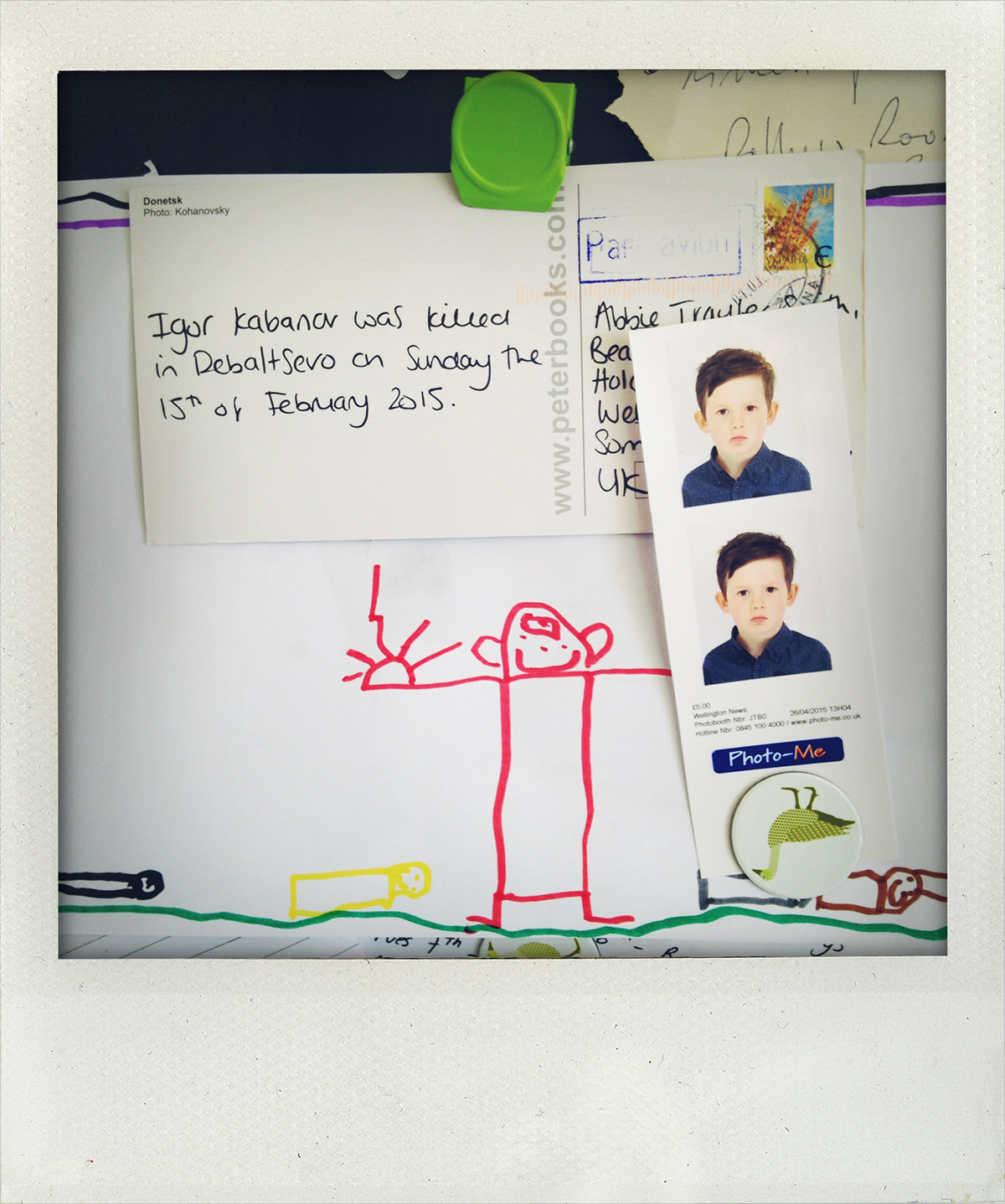
Welcome to Donetsk brings the war in Ukraine into the U.K. home of Abbie Trayler-Smith
These postcards do not deliver the news, nor do they provide much information at all; what they do is provide a catalyst for research, engagement, and conversation within foreign homes. Laurence Butet-Roch in Canada e-mailed me to say, “When I received the postcard, I was saddened by the news it delivered. Wanting to know more about the deceased, I turned to the closest research tool I had: Internet. In only a few clicks, I found out that Nikita Rusov was a hip-looking 12 year old and a seventh-grader. I also came across a gruesome video of the shelling’s aftermath. My thoughts are now with his family and friends.”
On the postcards, the names of once peaceful Ukrainian towns—Volnovakha, Gorlovka, Saur Mogila, Debaltseve, Grabovo—became ugly words, loaded with knowledge of the recent violence there. These are juxtaposed with the quaint, peaceful names of the towns to which the cards were sent—Pleasantville, Richmond, Arlington, Stanton Drew, Southsea, Annandale, Wetherby—sweet-sounding, idyllic names of places where the inhabitants are sure war will never reach. And written below them, the street names that represent the aspirations of the local communities: Valley View, Apple Creek Lane, Edenmore Avenue, Rainbow Drive, Elmfield Terrace, Daffodil Way.
As the postcards continue arriving at people’s homes, recipients photograph them in their own domestic spaces and share on social media the names of the people killed. On Instagram many recipients also use the hashtag #warispersonal. One user, Carlos Franco, wrote to me: “I received your postcard this morning here in Sao Paulo, Brazil. Proud to join this network to say to the world that every war is personal and stupid.”
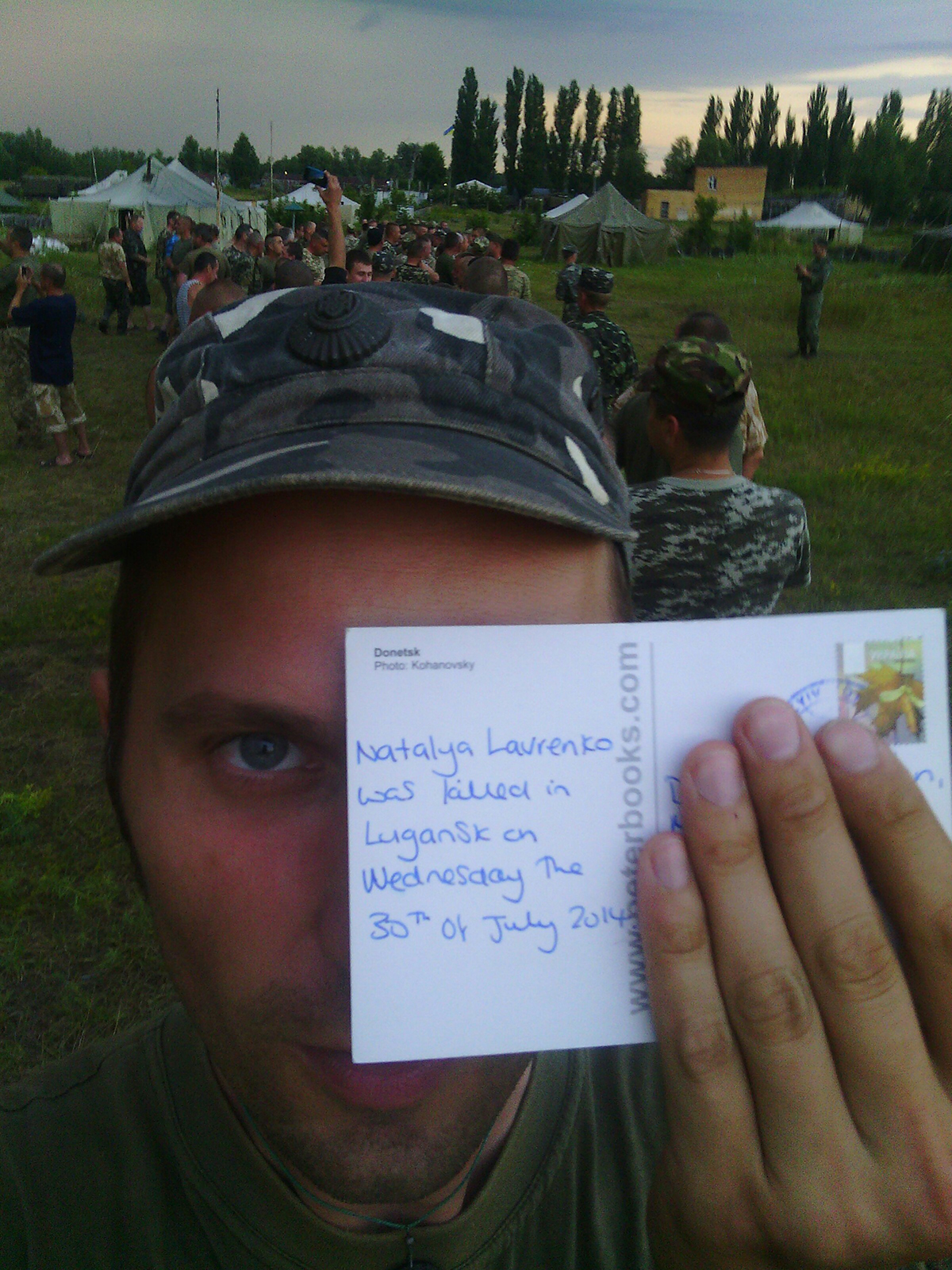
Dmitry Kupriyan, a soldier in the Ukrainian Army, was one of the few who received a postcard within Ukraine
The response to this work has been overwhelming: so many emotional responses from recipients, sometimes reflecting on their own experiences of bereavement; seeing them perform small intimate acts of remembrance for people they have never met; the way they have used the postcards as a catalyst to spread the news of the Ukrainian war in a very personal way to their family, friends, and social media community. Unexpectedly, the project has also reached many Ukrainians. I posted only 26 cards inside Ukraine, a few times to IDPs from Donbass and one to a soldier in the Ukrainian army. Ukrainian media have also reported on the project.
Though I am no longer working in Ukraine, I will continue collecting the names of those who die in the conflict. My aim is to formulate and translate into English a comprehensive list of the dead from all sides, something that does not yet exist. A friend in Ukraine collected another 2,000 postcards for me and I am gathering more addresses so that I can continue the project. My hope: to keep writing postcards until the war ends and I have recorded the name of every person to die in it.
It is our challenge to find new ways to engage people with what is happening in Ukraine. If people don’t care about the war, it is our job as journalists to tell stories in ways that make them care, in ways that move them and evoke empathy or connection. This is one small attempt to do that.
